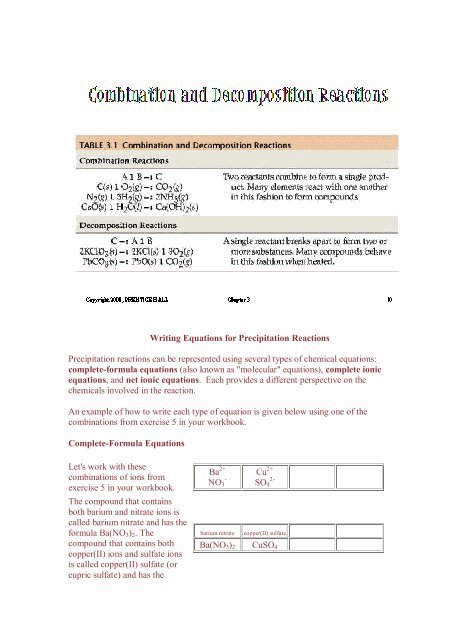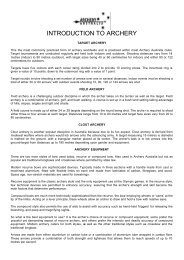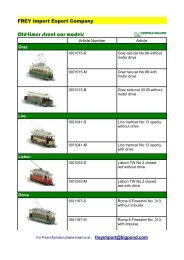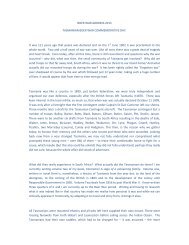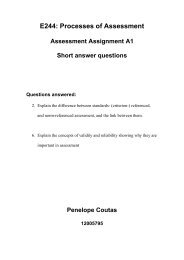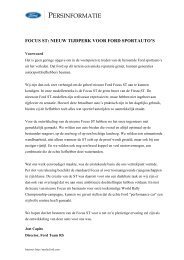Writing Equations for Precipitation Reactions Precipitation reactions ...
Writing Equations for Precipitation Reactions Precipitation reactions ...
Writing Equations for Precipitation Reactions Precipitation reactions ...
You also want an ePaper? Increase the reach of your titles
YUMPU automatically turns print PDFs into web optimized ePapers that Google loves.
<strong>Writing</strong> <strong>Equations</strong> <strong>for</strong> <strong>Precipitation</strong> <strong>Reactions</strong><br />
<strong>Precipitation</strong> <strong>reactions</strong> can be represented using several types of chemical equations:<br />
complete-<strong>for</strong>mula equations (also known as "molecular" equations), complete ionic<br />
equations, and net ionic equations. Each provides a different perspective on the<br />
chemicals involved in the reaction.<br />
An example of how to write each type of equation is given below using one of the<br />
combinations from exercise 5 in your workbook.<br />
Complete-Formula <strong>Equations</strong><br />
Let's work with these<br />
combinations of ions from<br />
exercise 5 in your workbook.<br />
The compound that contains<br />
both barium and nitrate ions is<br />
called barium nitrate and has the<br />
<strong>for</strong>mula Ba(NO 3 ) 2 . The<br />
compound that contains both<br />
copper(II) ions and sulfate ions<br />
is called copper(II) sulfate (or<br />
cupric sulfate) and has the<br />
Ba 2+<br />
NO 3<br />
-<br />
Cu 2+<br />
SO 4<br />
2-<br />
barium nitrate copper(II) sulfate<br />
Ba(NO 3 ) 2 CuSO 4
<strong>for</strong>mula CuSO 4 .<br />
When these compounds react<br />
with one another we get a double<br />
displacement reaction and the<br />
products are barium sulfate and<br />
copper(II) nitrate. The <strong>for</strong>mulas<br />
are BaSO 4 and Cu(NO 3 ) 2 .<br />
To balance this equation we<br />
have to make sure that we have<br />
the same number of bariums,<br />
nitrates, coppers, and sulfates on<br />
each side of the equation. We<br />
do, so the equation is balanced.<br />
Ba(NO 3 ) 2 + CuSO 4 BaSO 4 + Cu(NO 3 ) 2<br />
Please note that it is a coincidence that each<br />
<strong>for</strong>mula contains two nitrate ions. This is because<br />
both barium and copper ions have a charge of +2.<br />
<strong>Precipitation</strong> <strong>reactions</strong> are often represented using complete-<strong>for</strong>mula equations. Their<br />
advantage is that they show the compounds that are involved. Their disadvantage is<br />
that they do not show the <strong>for</strong>ms of the chemicals that are actually involved in the<br />
reaction. (Sometimes these equations are called "molecular" equations, even though<br />
the compounds are ionic rather than molecular.)<br />
Now please do exercise 6 in your workbook and check your answers be<strong>for</strong>e<br />
continuing with the lesson.<br />
Complete Ionic <strong>Equations</strong><br />
Complete ionic equations represent soluble ionic compounds as separated ions.<br />
Ba(NO 3 ) 2 + CuSO 4 BaSO 4 (ppt) + Cu(NO 3 ) 2<br />
Ba 2+ + 2 NO - 3 + Cu 2+ 2-<br />
+ SO 4 BaSO 4 (ppt) + Cu 2+ -<br />
+ 2 NO 3<br />
In the example shown above, barium nitrate exists in solution as separate barium ions<br />
and nitrate ions. Copper(II) sulfate exists in solution as separate copper(II) ions and<br />
sulfate ions. After the barium and sulfate ions combine to <strong>for</strong>m the solid barium<br />
sulfate precipitate, the copper(II) ions and the nitrate ions remain in solution. This<br />
representation is called the complete ionic equation. The barium and sulfate ions<br />
actually react to <strong>for</strong>m the barium sulfate product. The copper(II) ions and the nitrate<br />
ions are not actually invo<br />
ELECTROPHILIC ADDITION
The structure of ethene<br />
Background<br />
Electrophilic addition<br />
happens in many of the<br />
<strong>reactions</strong> of compounds containing carboncarbon<br />
double bonds - the alkenes.<br />
We are going to start by looking at ethene, because it is the simplest<br />
molecule containing a carbon-carbon double bond. What is true of<br />
C=C in ethene will be equally true of C=C in more complicated<br />
alkenes.<br />
Ethene, C 2 H 4 , is often modelled as shown on the right. The double<br />
bond between the carbon atoms is, of course, two pairs of shared<br />
electrons. What the diagram doesn't show is that the two pairs aren't<br />
the same as each other.<br />
One of the pairs of electrons is held on the line between the two carbon<br />
nuclei as you would expect, but the other is held in a molecular orbital<br />
above and below the plane of the molecule. A molecular orbital is a<br />
region of space within the molecule where there is a high probability<br />
of finding a particular pair of electrons.<br />
In this diagram, the line between the two carbon atoms represents a<br />
normal bond - the pair of shared electrons lies in a molecular orbital on<br />
the line between the two nuclei where you would expect them to be.<br />
This sort of bond is called a sigma bond.<br />
The other pair of electrons is found somewhere in the shaded part<br />
above and below the plane of the molecule. This bond is called a pi<br />
bond. The electrons in the pi bond are free to move around anywhere<br />
in this shaded region and can move freely from one half to the other.<br />
Note: This diagram shows a side view of an ethene molecule.<br />
The dotted lines to two of the hydrogens show bonds going back<br />
into the screen or paper away from you. The wedge shapes show<br />
bonds coming out towards you.<br />
The pi electrons are not as fully under the control of the carbon nuclei<br />
as the electrons in the sigma bond and, because they lie exposed above<br />
and below the rest of the molecule, they are relatively open to attack<br />
by other things.
Note: Check your syllabus to see if you need to know how a pi<br />
bond is <strong>for</strong>med. Haven't got a syllabus? Find out how to get one<br />
by following this link.<br />
If you do need to know about the bonding in ethene in detail,<br />
follow this link as well.<br />
Electrophiles<br />
An electrophile is something which is attracted to electron-rich regions<br />
in other molecules or ions. Because it is attracted to a negative region,<br />
an electrophile must be something which carries either a full positive<br />
charge, or has a slight positive charge on it somewhere.<br />
Note: The ending ". . phile" means a liking <strong>for</strong>. For example, a<br />
francophile is someone who likes the French; an anglophile is<br />
someone who likes the English.<br />
Ethene and the other alkenes are attacked by<br />
electrophiles. The electrophile is normally the<br />
slightly positive ( +) end of a molecule like<br />
hydrogen bromide, HBr.<br />
Note: If you aren't sure about why some bonds are polar, read the<br />
page on electronegativity.<br />
Use the BACK button on your browser to return to this page.<br />
Electrophiles are strongly attracted to the exposed electrons in the pi<br />
bond and <strong>reactions</strong> happen because of that initial attraction - as you<br />
will see shortly.<br />
You might wonder why fully positive ions like sodium, Na + , don't<br />
react with ethene. Although these ions may well be attracted to the pi<br />
bond, there is no possibility of the process going any further to <strong>for</strong>m<br />
bonds between sodium and carbon, because sodium <strong>for</strong>ms ionic bonds,<br />
whereas carbon normally <strong>for</strong>ms covalent ones.<br />
Addition <strong>reactions</strong>
In a sense, the pi bond is an unnecessary bond. The structure would<br />
hold together perfectly well with a single bond rather than a double<br />
bond. The pi bond often breaks and the electrons in it are used to join<br />
other atoms (or groups of atoms) onto the ethene molecule. In other<br />
words, ethene undergoes addition <strong>reactions</strong>.<br />
For example, using a general molecule X-Y . . .<br />
Summary: electrophilic addition <strong>reactions</strong><br />
An addition reaction is a reaction in which two molecules join together<br />
to make a bigger one. Nothing is lost in the process. All the atoms in<br />
the original molecules are found in the bigger one.<br />
An electrophilic addition reaction is an addition reaction which<br />
happens because what we think of as the "important" molecule is<br />
attacked by an electrophile. The "important" molecule has a region of<br />
high electron density which is attacked by something carrying some<br />
degree of positive charge.<br />
Note: When we talk about <strong>reactions</strong> of alkenes like ethene, we<br />
think of the ethene as being attacked by other molecules such as<br />
hydrogen bromide. Because ethene is the molecule we are<br />
focusing on, we quite arbitrarily think of it as the central molecule<br />
and hydrogen bromide as its attacker.<br />
There's no real justification <strong>for</strong> this, of course, apart from the fact<br />
that it helps to put things in some sort of logical pattern. In reality,<br />
the molecules just collide and may react if they have enough<br />
energy and if they are lined up correctly.<br />
Understanding the electrophilic addition<br />
mechanism<br />
The mechanism <strong>for</strong> the reaction between<br />
ethene and a molecule X-Y<br />
It is very unlikely that any two different atoms joined together will<br />
have the same electronegativity. We are going to assume that Y is<br />
more electronegative than X, so that the pair of electrons is pulled<br />
slightly towards the Y end of the bond. That means that the X atom
carries a slight positive charge.<br />
Note: Once again, if you aren't sure about electronegativity and<br />
bond polarity follow this link be<strong>for</strong>e you read on.<br />
Use the BACK button on your browser to return to this page.<br />
The slightly positive X atom is an electrophile and is attracted to the<br />
exposed pi bond in the ethene. Now imagine what happens as they<br />
approach each other.<br />
You are now much more likely to find the electrons in the half of the<br />
pi bond nearest the XY. As the process continues, the two electrons in<br />
the pi bond move even further towards the X until a covalent bond is<br />
made.<br />
The electrons in the X-Y bond are pushed entirely onto the Y to give a<br />
negative Y - ion.<br />
Help! Why does the carbon atom have a positive charge? The pi<br />
bond was originally made using an electron from each carbon
atom, but both of these electrons have now been used to make a<br />
bond to the X atom. This leaves the right-hand carbon atom an<br />
electron short - hence positively charged.<br />
Note also that we are only showing one of the pairs of electrons<br />
around the Y - ion. There will be other lone pairs as well, but we<br />
are only actually interested in the one we've drawn.<br />
Important term<br />
An ion in which the positive charge is carried on a<br />
carbon atom is called a carbocation or a<br />
carbonium ion (an older term).<br />
In the final stage of the reaction the electrons in the lone pair on the Y -<br />
ion are strongly attracted towards the positive carbon atom. They<br />
move towards it and <strong>for</strong>m a co-ordinate (dative covalent) bond<br />
between the Y and the carbon.<br />
Help! A co-ordinate (dative covalent) bond is simply a covalent<br />
bond in which both shared electrons originate from the same<br />
atom. The bond <strong>for</strong>med between the X and the other carbon atom<br />
was also a co-ordinate bond. Once a co-ordinate bond has been<br />
<strong>for</strong>med there is no difference whatsoever between it and any other<br />
covalent bond.<br />
How to write this mechanism in an exam<br />
The movements of the various electron pairs are shown using curly<br />
arrows.<br />
Help! If you aren't sure about the use of curly arrows in<br />
mechanisms, you must follow this link be<strong>for</strong>e you go on.
Use the BACK button on your browser to return to this page.<br />
Don't leave this page until you are sure that you understand how this<br />
relates to the electron pair movements drawn in the previous diagrams.<br />
Where would you like to go now?<br />
To menu of electrophilic addition <strong>reactions</strong>. . .<br />
To menu of other types of mechanism. . .<br />
To Main Menu . . .<br />
© Jim Clark 2000<br />
Addition polymerization involves the linking together of molecules incorporating<br />
double or triple chemical bonds. These unsaturated monomers (the identical<br />
molecules which make up the polymers) have extra, internal, bonds which are able to<br />
break and link up with other monomers to <strong>for</strong>m the repeating chain. Addition<br />
polymerization is involved in the manufacture of polymers such as polyethene,<br />
polypropylene and polyvinyl chloride (PVC). A special case of addition<br />
polymerization leads to living polymerization.<br />
Condensation polymerization occurs when monomers bond together through<br />
condensation <strong>reactions</strong>. Typically these <strong>reactions</strong> can be achieved through reacting<br />
molecules incorporating alcohol, amine or carboxylic acid (or other carboxyl<br />
derivative) functional groups. When an amine reacts with a carboxylic acid an amide<br />
or peptide bond is <strong>for</strong>med, with the release of water (hence condensation
polymerization.) This is the process through which amino acids link up to <strong>for</strong>m<br />
proteins, as well as how kevlar is <strong>for</strong>med.<br />
The chain growth-step growth system categorizes polymers based on their mechanism.<br />
While most polymers will fall into their similar category from the additioncondensation<br />
method of categorization, there are a few exceptions.<br />
Chain growth polymers are defined as polymers <strong>for</strong>med by the reaction of monomer<br />
with a reactive center. These polymers grow to high molecular weight at a very fast<br />
rate. It is important to note that the overall conversion rates between chain and step<br />
growth polymers are similar, but that high molecular weight polymers are <strong>for</strong>med in<br />
addition <strong>reactions</strong> much more quickly than with step polymerizations.<br />
Step growth polymers are defined as polymers <strong>for</strong>med by the stepwise reaction<br />
between functional groups of monomer. Most step growth polymers are also classified<br />
as condensation polymers, but not all step growth polymers (like polyurethanes<br />
<strong>for</strong>med from isocyanate and alcohol bifunctional monomers) release condensates.<br />
Step growth polymers increase in molecular weight at a very slow rate at lower<br />
conversions and only reach moderately high molecular weights at very high<br />
conversion (i.e. >95%).<br />
To alleviate inconsistencies in these naming methods, adjusted definitions <strong>for</strong><br />
condensation and addition polymers have been developed. A condensation polymer is<br />
defined as a polymer that involves elimination of small molecules during its synthesis,<br />
or contains functional groups as part of its backbone chain, or its repeat unit does not<br />
contain all the atoms present in the hypothetical monomer to which it can be degraded.<br />
Addition polymerization involves the breaking of double or triple bonds, which are<br />
used to link monomers into chains. In the polymerization of ethene (fig. 1), its pi bond<br />
is broken and these two electrons rearrange to create a new propagating center like the<br />
one that attacked it. The <strong>for</strong>m this propagating center takes depends on the specific<br />
type of addition mechanism. There are several mechanisms through which this can be<br />
initiated. The free radical mechanism was one of the first methods to be used. Free<br />
radicals are very reactive atoms or molecules which have unpaired electrons. Taking<br />
the polymerization of ethene as an example, the free radical mechanism can be<br />
divided in to three stages: initiation, propagation and termination.<br />
Initiation is the creation of free radicals necessary <strong>for</strong> propagation. The radicals can be<br />
created from radical initiators, such as organic peroxide molecules, molecules<br />
containing an O-O single bond, by reacting oxygen with ethene. The products <strong>for</strong>med<br />
are unstable and easily break down into two radicals. In an ethene monomer, one<br />
electron pair is held securely between the two carbons in a sigma bond. The other is
more loosely held in a pi bond. The free radical uses one electron from the pi bond to<br />
<strong>for</strong>m a more stable bond with the carbon atom. The other electron returns to the<br />
second carbon atom, turning the whole molecule in to another radical.<br />
Propagation is the rapid reaction of this radicalised ethene molecule with another<br />
ethene monomer, and the subsequent repetition to create the repeating chain.<br />
Termination occurs when a radical reacts in a way that prevents further propagation.<br />
The most common method of termination is by coupling where two radical species<br />
react with each other <strong>for</strong>ming a single molecule. Another, less common method of<br />
termination is disproportionation where two radicals meet, but instead of coupling,<br />
they exchange a proton, which gives two terminated chains, one saturated and the<br />
other with a terminal double bond.<br />
Free radical addition polymerization of ethylene must take place at high temperatures<br />
and pressures, approximately 300°C and 2000 At. While most other free radical<br />
polymerizations do not require such extreme temperatures and pressures, they do tend<br />
to lack control. One effect of this lack of control is a high degree of branching. Also,<br />
as termination occurs randomly, when two chains collide, it is impossible to control<br />
the length of individual chains. A newer method of polymerization similar to free<br />
radical, but allowing more control involves the Ziegler-Natta catalyst.<br />
The problem of branching occurs during propagation, when a chain curls back on<br />
itself and breaks - leaving irregular chains sprouting from the main carbon backbone.<br />
Branching makes the polymers less dense and results in low tensile strength and<br />
melting points. Developed by Karl Ziegler and Giulio Natta in the 1950s, Ziegler-<br />
Natta catalysts (triethylaluminium in the presence of a metal(IV) chloride) largely<br />
solved this problem. Instead of a free radical reaction, the initial ethene monomer<br />
inserts between the aluminium atom and one of the ethyl groups in the catalyst. The<br />
polymer is then able to grow out from the aluminium atom and results in almost<br />
totally unbranched chains. With the new catalysts, the tacticity of the polypropene<br />
chain, the alignment of alkyl groups, was also able to be controlled. Different metal<br />
chlorides allowed the selective production of each <strong>for</strong>m i.e., syndiotactic, isotactic and<br />
atactic polymer chains could be selectively created.<br />
However there were further complications to be solved. If the Ziegler-Natta catalyst<br />
was poisoned or damaged then the chain stopped growing. Also, Ziegler-Natta<br />
monomers have to be small, and it was still impossible to control the molecular mass<br />
of the polymer chains. Again new catalysts, the metallocenes, were developed to<br />
tackle these problems. Due to their structure they have less premature chain<br />
termination and branching.<br />
Other <strong>for</strong>ms of addition polymerization include cationic and anionic polymerization.<br />
While not used to a large extent in industry yet due to stringent reaction conditions<br />
such as lack of water and oxygen, these methods provide ways to polymerize some<br />
monomers that cannot be polymerized by free radical methods such as polypropylene.<br />
Cationic and anionic mechanisms are also more ideally suited <strong>for</strong> living<br />
polymerizations, although free radical living polymerizations have also been<br />
developed.


